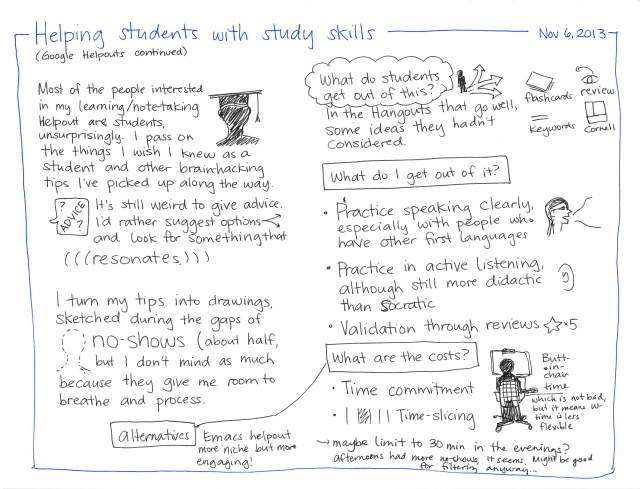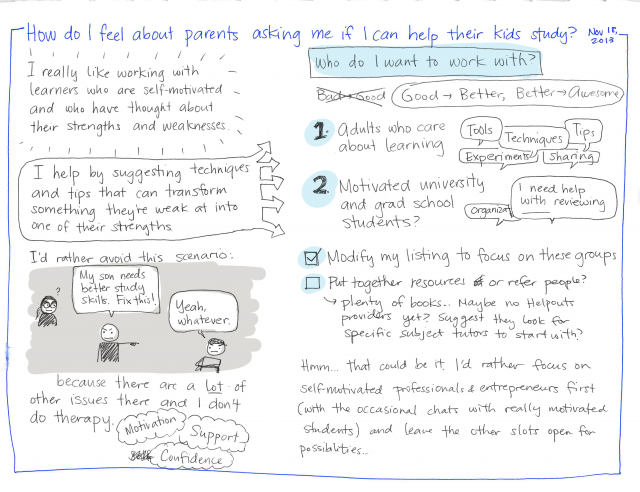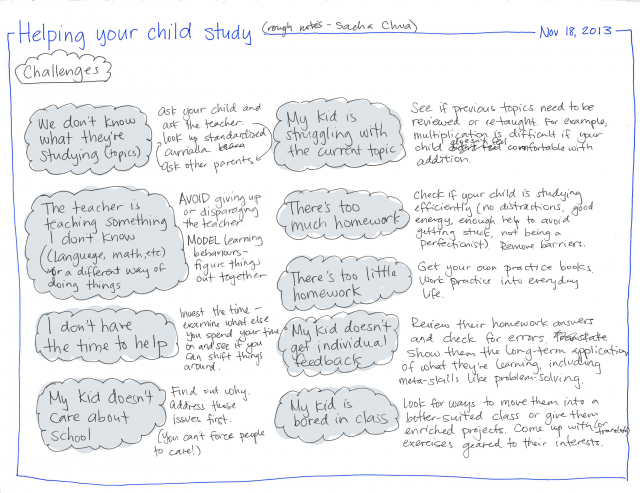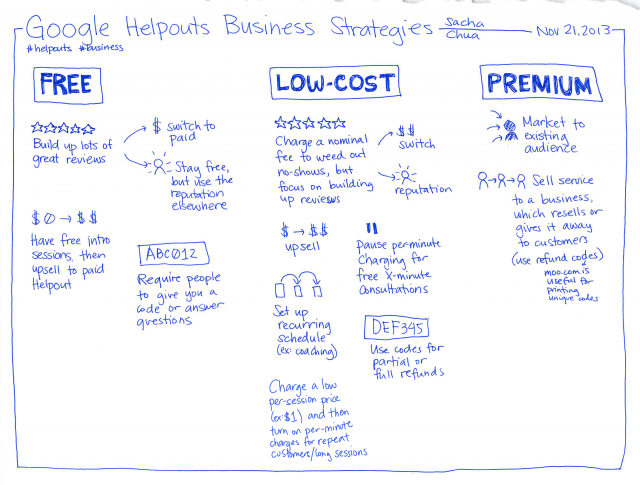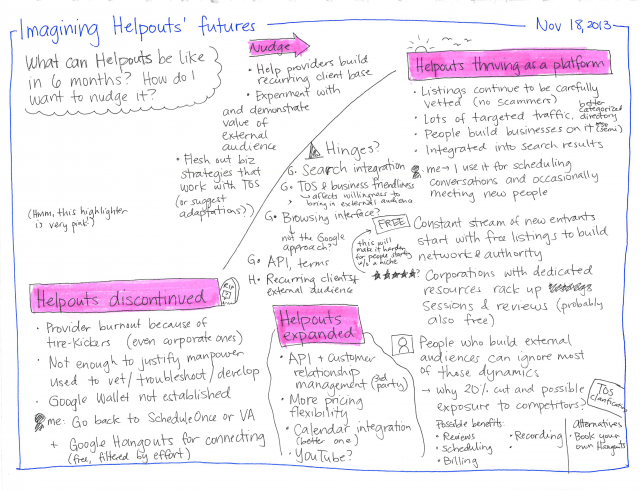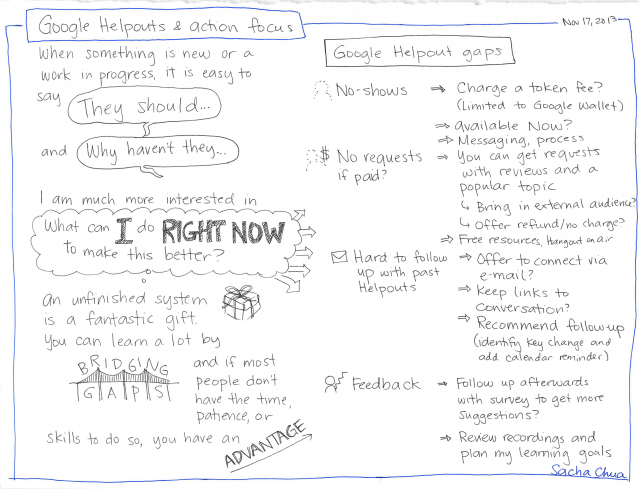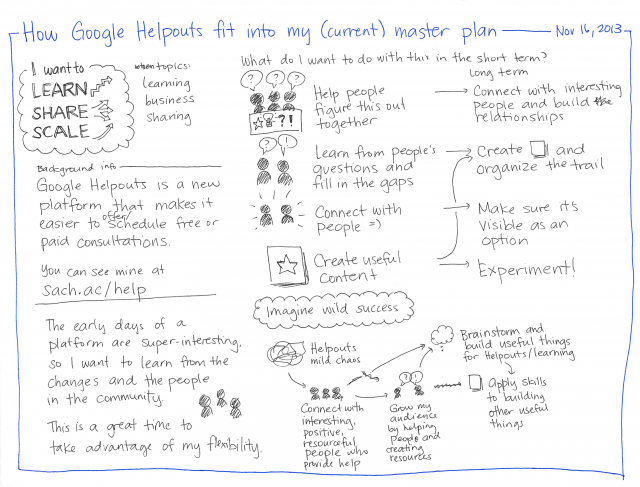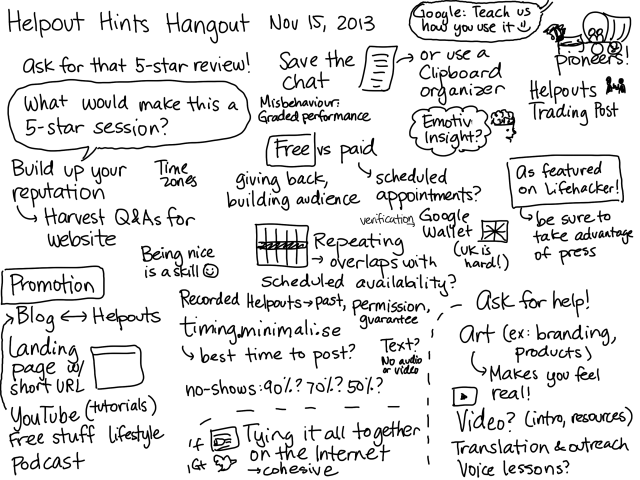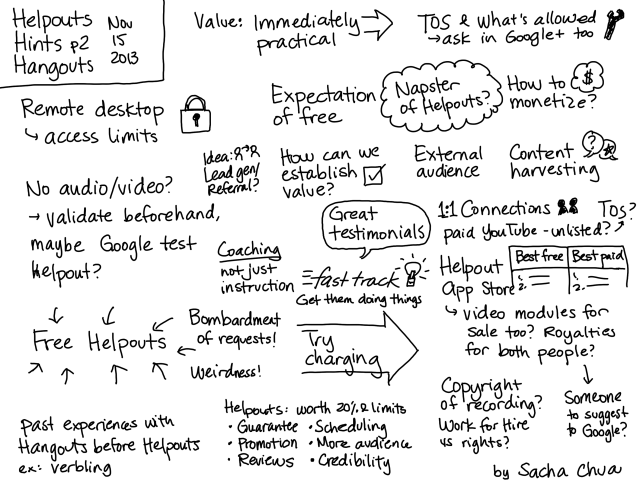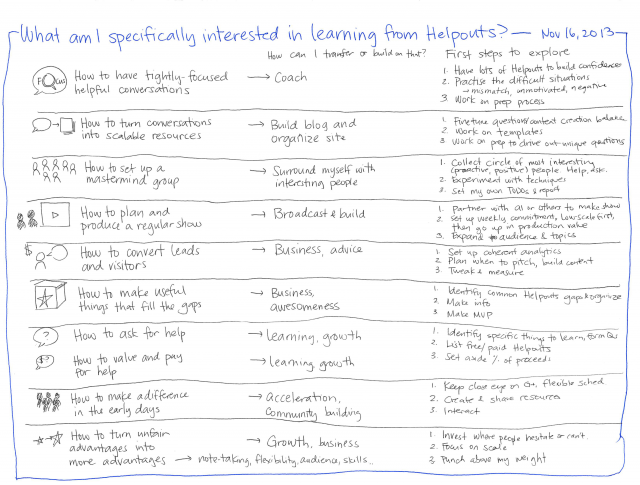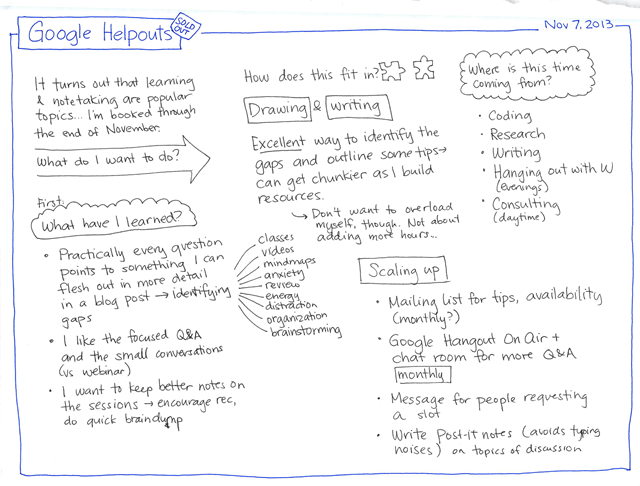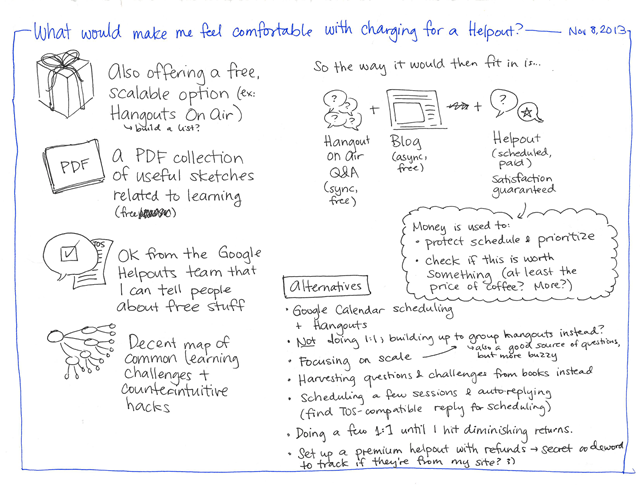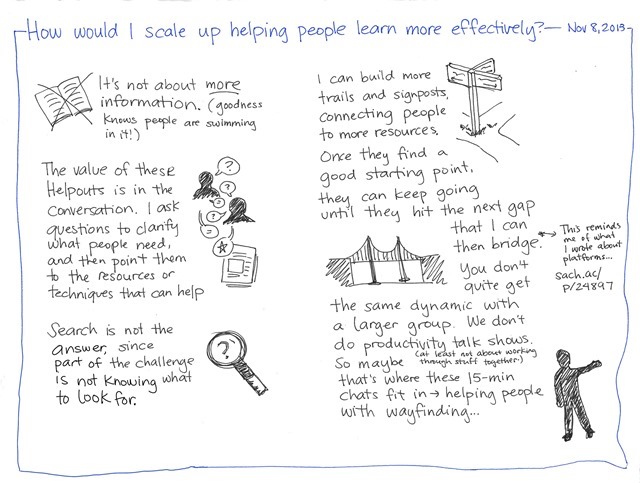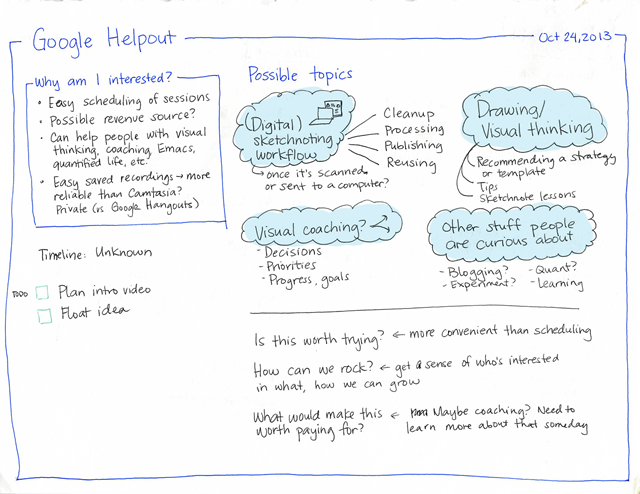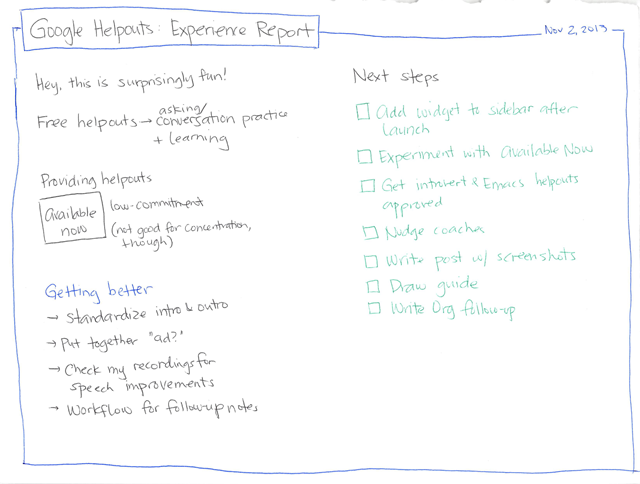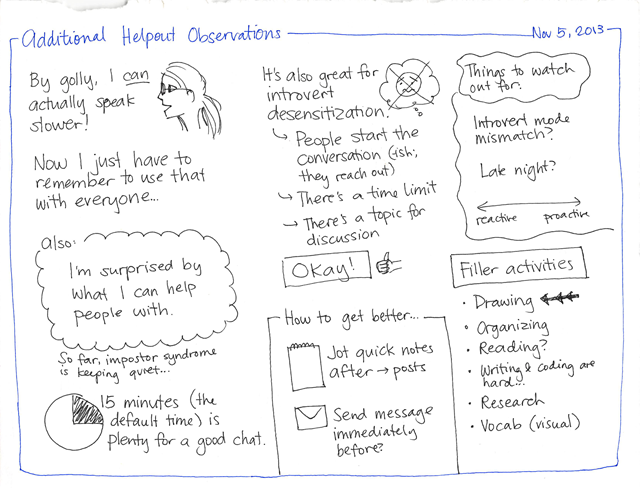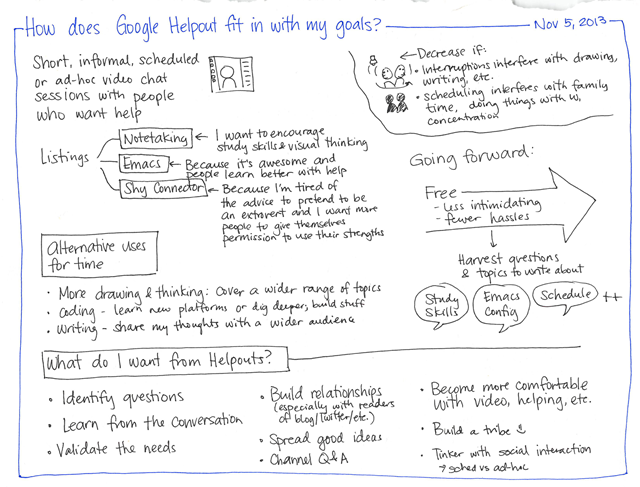Update 2013-07-31: You can find a table of contents and associated links at http://sach.ac/accel. Here’s the video!
Quick link to talking points as a Mural.ly map
From time to time, I say interesting-enough things that make people want to pick my brain further. When people do, this is excellent! Sometimes I don’t know what people will find useful or interesting until they ask. When the opportunity comes up, I try to wring out as much as I can. In the podcast interviews I’ve done so far, I’ve always been delighted by what we learn from the conversation.
An interview is entirely different from a presentation, and it would be a waste to treat it as one. I love where other people’s questions, interests, and experiences can lead me. So I don’t want to structure it too much – but I also want to give people the benefit of clear thoughts and useful replies. Having struggled with making good conversation myself, I also want to help people find things that they or other people will like instead of wandering until they bump into something good.
It’s a little like the media training I got when I was at IBM. One of the tips I remember is to think about your story before you talk to people. You don’t have to stick to the script, but you should know the key points you want to get across, and try some ways of expressing it so that you can be clear and concise.
So here’s what I e-mailed to Timothy Kenny in preparation for our chat about accelerated learning (which will be this afternoon):
I thought about what I do the most differently and what your subscribers will probably benefit from. Here are some topic ideas. How about picking whichever one you think will resonate the most? =) I’m sure there’ll be future conversations, so we don’t have to get everything covered in one chat.
- Sketchnotes
- Ideal outcome: People are inspired to take visual notes for their own use
- Learning and reviewing presentations and books; Connecting with people; Understanding your thoughts; Sharing what you know
- Making the most of your blog through the years
- Ideal outcome: People are encouraged to blog for the long term; people who have been blogging a while are inspired to organize their work
- Weekly, monthly, yearly reviews; Indexes; Other people as part of your memory; Collections; Backups
- Tracking and experiments
- Ideal outcome: People are inspired to make better decisions by tracking
- Time; Money and an opportunity fund; Clothes, decisions, etc.; 5-year experiment with retirement
- How it all fits together
- Ideal outcome: People see how the different techniques can support each other, and they are motivated to take the next step
- The flow of learning; How different techniques work together; Getting started; Getting better; Going from strength to strength
- Continuous improvement in everyday life
- Ideal outcome: People examine their processes
- Understanding your processes; Handling weaknesses; Building on strengths; Learning from experiments
He wrote back to say that he was curious about sketchnotes, blogging, connecting, learning flow, and what I considered my strengths and weaknesses in terms of learning.
I spent some time on Saturday night thinking about what I’ve learned and what I want to help other people learn. A podcast isn’t the place for technical instruction; blog posts are better for that because I can include step-by-step tips, links, and other resources. A podcast or videocast is great at communicating enthusiasm, helping other people see that they can get started. It’s also great for the back-and-forth, bringing two people’s ideas together.
So my goals for the chat are:
- Inspire people to learn more about some learning techniques that they might find useful
- Encourage people to get in touch with me
- Explore follow-up questions that I may want to write about or draw
- Learn interesting things about Timothy Kenny or share other tidbits that can lead to further conversations
In preparation, I drew this on Saturday. (Click on the image for a larger version!)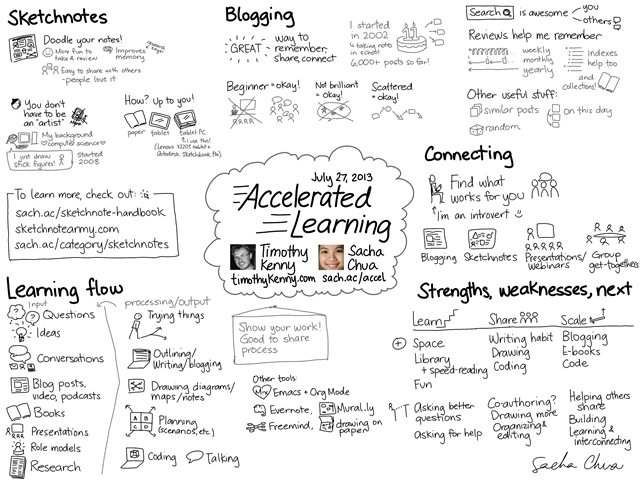
(Not only do I sketchnote events, but I can sketchnote the future!  )
)
The idea is that these talking points can let Timothy pick whatever he wants to focus on, while giving him a peripheral awareness of related topics or other things we can talk about. They also give me visual aids that I can refer to (or draw on top of!) during the chat, which is probably more interesting than watching a bunch of talking heads. And if we run out of time or focus on some things instead of others, no worries – the blog post and the sketchnote will be there as a way to follow up. =)
I’ve done this before, like the digital sketchnoting workflow that I sketched in preparation for my podcast with Mike Rohde (episode, transcript). Our target time for that was 12 minutes, so it was great to be able to zoom in and talk about key parts knowing that other things could be left for the blog post or sketchnote.
I discovered the power of sharing my notes (showing my work!) when I was giving a lot of presentations. Knowing that my talking points were on the Net somewhere (ex: my Shy Connector presentation for Women in Technology International, or my talk on How to use Evernote to improve your visual thinking) meant that I didn’t have to worry about forgetting anything important, because people can always look up my notes. It gave me more freedom to ad-lib or go off-script, too, following whatever people were interested in.
So really, the main reason to come to one of my presentations or to interview me is to ask questions and figure out answers together, which is exactly the way I want it. If I can do the braindump outside the time we have, then we can use the time for interaction. In presentations and conversations, I want to give people just enough to get good questions. Questions are my pay-off for the preparation. Questions spark my curiosity and turn into follow-up conversations and blog posts and presentations.
Unrelated observation: making my own URL shortening thing was totally worth it, even if the domains are expensive. Much better than squeezing long domain names into my sketchnotes. Although I’m still flipflopping between sach.ac and liv.gd in sketchnotes because I think my nickname is hard to spell… Any opinions?
I’ll post the recording when it’s up, and I’ll probably work on transcribing it too. Fun!
Here’s the e-mail announcement that Timothy sent:
Hundreds of years ago during the Renaissance, creative geniuses like DaVinci revolutionized science by visualizing information for the first time. Huge leaps were made in engineering, math, architecture and physics because of this new focus on visualizing information.
A new visual Renaissance is coming…
Today at 1PM EDT (New York Time) I’m interviewing Sacha Chua on her accelerated learning techniques and especially how she visualizes information to learn faster and understand new concepts better.
Click Here to Join the Hangout:
https://plus.google.com/events/c1irfbcfio2q6qn20387trhdnjk
Sacha is also a programmer. Programmers have the ability to see and create systems because coding requires that you build a system to process information.
All businesses are systems. And the more you can systematize your business the more stress free it will be for you. The starting point for understanding systems is learning how to get them down on paper as visual diagrams (much the same way programmers sketch out their program on a white board before building it) and that is a big piece of what we will be discussing today.
We’re doing it live so you can chime in with questions or observations during the interview.
Why You Should Come
Many people know about learning and productivity hacks but I have never met someone who actually put so many of them together into such a coherant system.
Sacha is also a visual genius. She created both of the images below. You will learn how she does it and why it is so important to get comfortable drawing and visualizing for your business and your learning.
What We Will Talk About

Example of Sacha’s 1 page visual book reviews
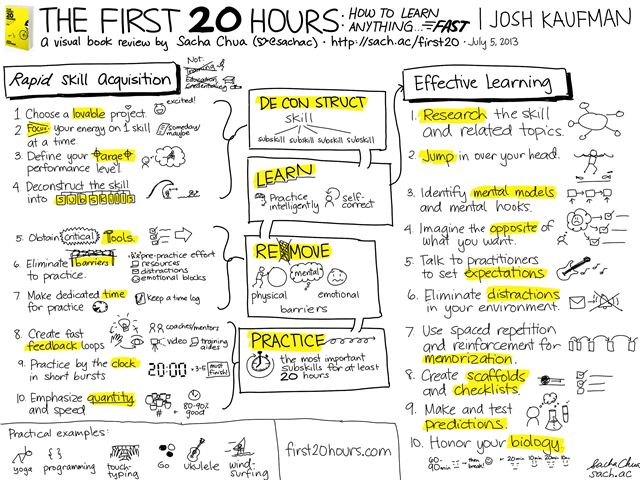
See you at 1,
Timothy
PS
Sign up for the Hangout here, then check out the learning profile I did on Sacha here:
http://timothykenny.com/accelerated-learning/accelerated-learning-profile-sacha-chua
